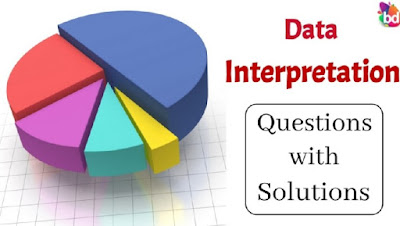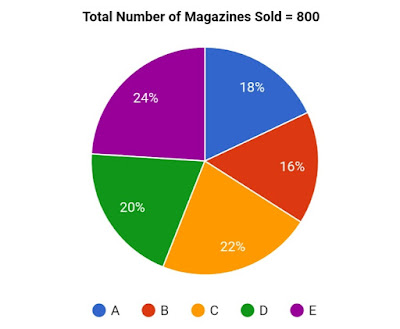DI Set – 4
There are five shops A, B, C, D and E. They sell two different magazines – India Today and Outlook. The following given pie chart shows the total number of magazines sold by different shops in a particular month.
Q.1) If the total number of Outlook magazines sold by shop B and that by shop C are equal and the ration of India Today magazines sold by shop B to that sold by shop C is 2:3, then find the total number of Outlook magazines sold by B and C together.
(a) 80
(b) 32
(c) 64
(d) 96
(e) 108
Solution
Let the number of Outlook magazines sold by shop B be ‘x’
Then,
(16% of 800-x) / (22% of 800-x) = 2/3
As we all know,
So,
16% of 800 = (10% + 5% + 1%) of 800 = 80 + 40 + 8 = 128
Similarly,
22% of 800 = (20%+2%) of 800 = 160+16 = 176
Now the above formed equation can be written as,
=> (128-x) / (176-x) = 2/3
=> 384 – 3x = 352 – 2x
=> x = 32
So, the total number of Outlook magazines sold by both the shops B and C together will be = 32+32 = 64
Hence, option (c) is the right answer.
Q.2) If the total number of Outlook magazines sold by all the shops together is 58% of the total number of magazines sold by all the shops, then find the difference between number of India Today magazines sold by all the shops together and the number of Outlook magazines sold by all the shops together.
(a) 85
(b) 132
(c) 144
(d) 154
(e) 128
Solution : As given in the question that, total number of Outlook magazines sold by all the shops together is 58% of the total number of magazines sold by all the shops. Now this means that (100-58)% = 42% are India Today magazines.
So Required Difference,
=> (58% – 42%) of 800
=> 16% of 800
=> (10% + 5% + 1%) of 800
=> 80+40+8
=> 128 [ANS]
Hence, Option (e) is the right answer.
Q.3) If the total number of magazines sold by shop C is 25% more and that by E is 12.5% more in the next month, then what is the total number of magazines sold by shop C and E together in the next month ?
(a) 480
(b) 432
(c) 380
(d) 436
(e) 524
Solution :
Here for simplicity we can write that,
25% more means,
=> 100% +25% = 125% = 125/100
And similarly 12.5% more means,
=> 100%+12.5% = 112.5% = 112.5/100
Now,
25% more magazines sold by shop C,
=> 22% of 800 × 125/100
=> (20%+2%) of 800 × 125/100
=> (160+16) × 125/100
=> 176 × 5/4
=> 220
12.5% more magazines sold by shop E,
=> 24% of 800 × 112.5/100
=> (20% + 4%) of 800 × 112.5/100
=> (160+32) × 112.5/100
=> 192 × 112.5/100
=> 216
So, Required Total number of magazines,
=> 220+216
=> 436 [ANS]
Hence, Option (d) is the right answer.
Q.4) The total number of magazines sold by A is equal to 36% of the total magazines purchased by shop A, then what is the total number of unsold magazines of shop A ?
(a) 276
(b) 216
(c) 356
(d) 256
(e) 208
Solution : Let us first calculate the total number of magazines sold by A,
=> 18% of 800
Now as we all know,
=> (10%+8%) of 800
=> 80 + (10%-2%) of 800
=> 80 + (80-16)
=> 80 + 64
=> 144
As given in the question, total number of magazines sold by A is equal to 36% of the total magazines purchased by shop A.
So from this we can understand that, the total number of unsold magazines of shop A will be (100%-36%) = 42% of total magazines purchased by shop A.
Therefore, it can be written as
36% ———–> 144
42% ———–> ?
After cross multiply,
=> ? = (144×42) / 36
=> ? = 256 [ANS]
Hence, Option (d) is the right answer.
Q.5) Find the ratio of number of magazines sold by shop C to the number of magazines unsold by shop D.
(a) 11 : 40
(b) 17 : 60
(c) 16 : 27
(d) 9 : 16
(e) 11 : 20
Solution :
Magazines sold by shop C = 22% of 800
Magazines unsold by shop D = (100-20)% of 800
Required Ratio,
=> 22% of 800 : 80% of 800
=> 176 : 640
[Tip : 22% of 800 = (20% + 2%) of 800 = 160 + 16 = 176, similarly 80% of 800 = 800 – (20% of 800) = 800-160 = 640]
Do remember,
Now,
=> 176 : 640 can be written as,
=> 44 : 160, or
=> 11 : 40 [ANS]
Hence, Option (a) is the right answer.
Note : Don’t write these long sentences while solving the question in exam, they are written only to give you a proper explanation. Just cut short the steps by trying to understand the method or logic behind it and do most of the calculations in mind inorder to save the time.
That’s all in this article, if you have any doubt, feedback or suggestion then please feel free to comment below. Keep Sharing and Happy Learning.
For more solved examples of Data Interpretation – Click Here
Thank You !!
Join our Telegram Channel : t.me/bankingdreams




Leave a Comment